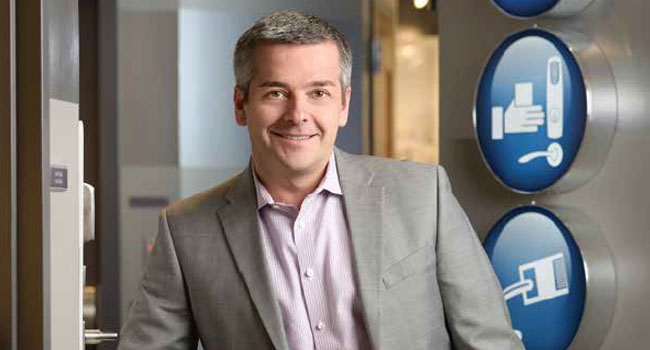
Changes are Coming
- By Ralph C. Jensen
- May 01, 2015
During the past 10 years there have been some
magnificent technological innovations in the
security industry, but the pace of change has
never been higher. One can make a strong argument
that the next 10 years will bring an even greater rate
of change.
One of the companies spearheading this change
and innovation is ASSA ABLOY, and many of the
new access control technologies come out of the Access
and Egress Hardware Group of ASSA ABLOY
where Martin Huddart is the president.
“One of the biggest technology advances we’ve
seen in the past 10 years is intelligent locks,” Huddart
said. “By integrating several access control components
into one smart, integrated device on the door,
access control costs and energy consumption can be
radically reduced.”
“IP-enabled locks have allowed facilities to bring access
control deeper into the facility by re-using their existing
IT infrastructure. ASSA ABLOY Group brands
Corbin Russwin and SARGENT offer PoE locks that
have been recognized for their contribution to sustainable
buildings. These PoE locks streamline the installation
process, reduce costs and components, and can
minimize power consumption by about 90 percent.”
Wireless locks have become mainstream in the industry
where end users want more control at affordable
costs per opening. ASSA ABLOY offers WiFi
locks where no additional wireless infrastructure is
needed. As an alternative, Aperio wireless technology
has made it possible to address a broader range
of applications never before possible, giving facilities
greater control and efficiency.”
Another important innovation in sustainable
access control is EcoFlex technology. Available in
Corbin Russwin and SARGENT electrified mortise
locks, it has been GreenCircle certified to save up to
96 percent is energy costs. Huddart said this can represent
significant s avings for customers. “In a campus
setting with hundreds or thousands of doors, reducing
energy costs by $15 per door can be significant,”
Huddart said. When combined with some of the new
clever EcoPower supplies from Securitron, the savings
in total energy consumed can be 99 percent.
“We will see more change in the lock and power
supply business in the next 10 years. For example, we
now understand that by designing products that consume
less power, we are not only helping the environment,
but can also have a positive impact on an organization’s
sustainability objectives,” said Huddart.
Looking to the future, mobile access will make
a profound impact on the industry as smartphones
begin to replace mechanical keys or RFID credentials.
The convenience and security of mobile access
will drive widespread adoption in both residential
and commercial markets.
Looking even further into the future, openings
will feature detailed door monitoring, real-time diagnostics
and the sharing of information to the cloud.
Huddart said that ‘highly intelligent openings’ will
offer easier installation and troubleshooting, and an
extended life of the components.
Huddart added that ASSA ABLOY is a strong
proponent of open architecture, wireless, and mobile
capabilities. Putting these elements together in creative
new ways is opening up new markets that have
been historically underserved. For example, Yale is
launching new simple but powerful solutions into
multi-family housing markets to control tenant and
common area openings using smart cards or phones.
Yale also provides commercial locks for small businesses
wanting to extend the new Z-Wave or Zigbee
wireless capabilities of their burglar alarm panels.
“Yale Locks has provided a bridge between intrusion
and access for the very first time,” said Huddart. “We
are creating a compelling business case for the small
business to upgrade mechanical locks to a system
with more visibility and control over employees”.
There are other vertical markets where Huddart
and his team are focused. Healthcare and universities
are at the top of the list. He said there is a greater
emphasis than ever before on physical security at
schools, and for good reason. Schools need to provide
a safe and secure learning environment, and in an
emergency, teachers must be able to lock their classroom
doors and feel at ease.
“We are at a time when there is an unprecedented
rate of change,” Huddart said. “There have never
been so many great choices to make our buildings
safe, secure and cost effective.”
This article originally appeared in the May 2015 issue of Security Today.
About the Author
Ralph C. Jensen is the Publisher/Editor in chief of Security Today magazine.